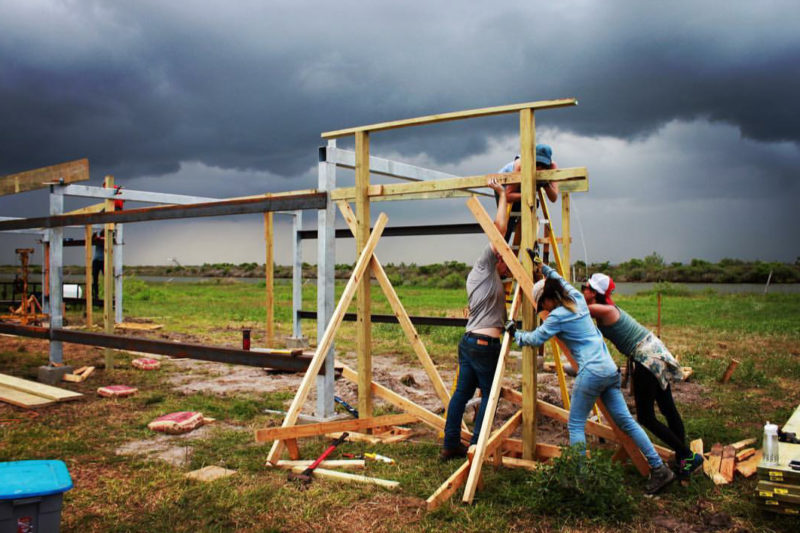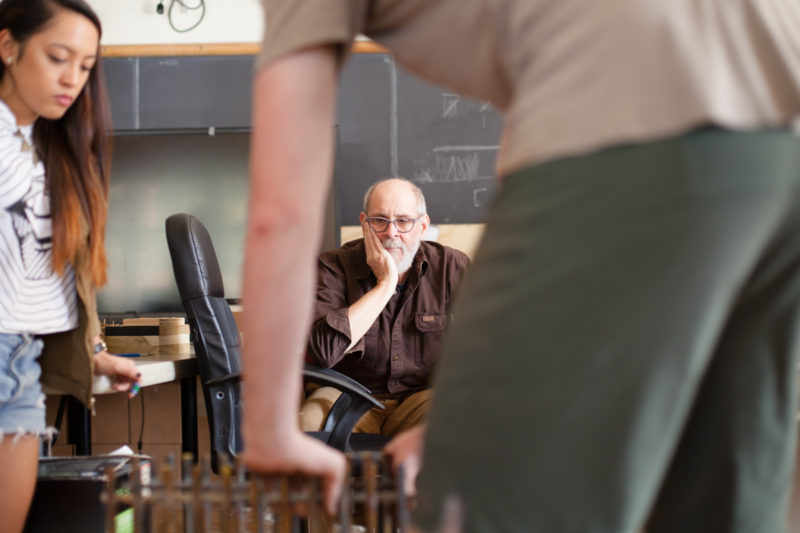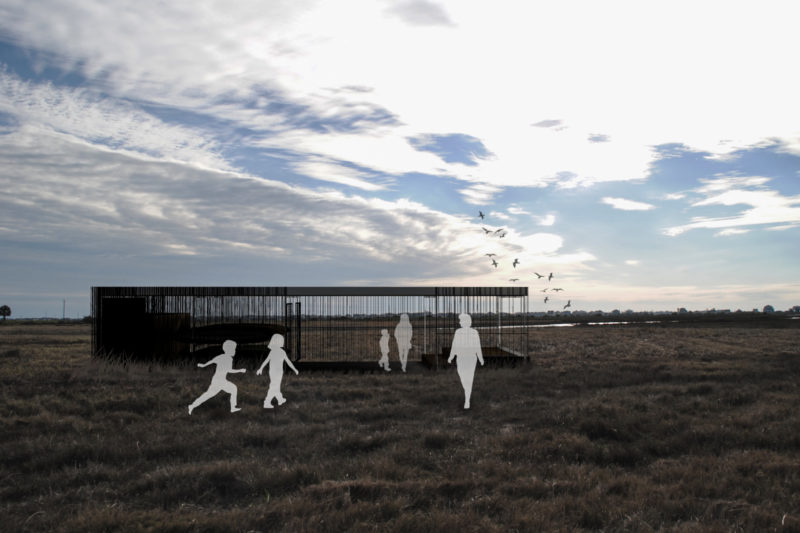Architecture Students Get Out of the Classroom to Help Preserve Coast
By Yi Li
Photography By Austin Price
Reporting Texas

The students in the Gulf Coast DesignLab practice welding before beginning the building phase of their project. Most had never used construction tools before. Austin Price/Reporting Texas
One day in January, Karla Klay and her husband were bicycling through the campsite in Goose Island State Park near Rockport.
Klay camps in the park almost every year. But that day, she came across some structures she hadn’t seen before: an outdoor classroom with a fire circle and a seating area shaded by live oaks, plus a storage area for kayaks.
She knew immediately that something like it would be ideal for Artist Boat, a Galveston-based nonprofit that works to promote awareness about preserving coastal areas and the marine environment, including with kayak trips for school children in Galveston Bay.
“I knew I wanted something like that for the coastal heritage preserve that Artist Boat has formed on West Galveston Island,” recalled Klay, who is Artist Boat’s executive director.
That led her to the University of Texas at Austin’s School of Architecture, where students in one class have spent the semester designing an outdoor classroom and kayak storage facility for Klay. After weeks of hard work, they’re in the home stretch, trucking the materials to the site, where they’ll assemble them over three long weekends.

Students from the DesignLab went to the coast to build the structures they designed, which will take three long weekends. Photo courtesy of Gulf Coast DesignLab
The students are from the Gulf Coast DesignLab, a one-semester program that began in 2012.
Design Lab’s mission is to encourage environmental stewardship by having students design and build facilities for environmental education along the Texas Gulf Coast.
Over the past five years, students have collaborated with several state parks and nonprofits on projects such as a wetlands observation platform in Goose Island State Park, a pavilion for the Marine Science Institute at Port Aransas and several floating platforms at Sea Rim State Park at Sabine Pass, which environmental groups can use for camping. The Artist Boat project will be the tenth project the class has undertaken.
“No other university works specifically on the coast and working directly with environmental education goals,” said Coleman Coker, an adjunct professor of architecture and director of the lab.

Coleman Coker, director of the DesignLab, said the mission of the course is to encourage students to become stewards of the coast, which faces threats such as rising sea levels. Austin Price/Reporting Texas
Coker previously lived in New Orleans and experienced the impact of Hurricane Katrina, which devastated many sections of the Gulf Coast.
“I learned firsthand about the vulnerability of coastal cities,” he said, including that much of the man-made infrastructure could make the damage from natural disasters even worse.
That is a particular concern in Texas, which has a concentration of petrochemical and oil refineries along the coast. Additionally, groundwater pumping has cause the shoreline to subside. In the Houston area, that has increased the frequency of floods and caused the loss of wetland habitat, according to the U.S. Geological Survey.
Because the damage happens slowly, it’s invisible to many people, Klay said. “People associate sea level rise only with climate change, but sea level rise also can occur because land subsides. On the Gulf Coast of Texas, we’ve lost 50,000 acres of wetlands due to subsidence.”
Those forces create challenges for architects, Coker said.
“Young designers in schools today will inevitably need to grapple with issues brought about by rising sea level and more severe weather events,” he said. “Coastal cities will need to redesign much of their fundamental infrastructures, as coastal citizens worldwide face dynamic change brought about by global warming.”
Artist Boat’s work includes conducting kayak trips in West Galveston Bay for middle and high school students from economically disadvantaged public schools.
Fifteen UT students in the DesignLab had 15 weeks and $20,000 to design and build a storage structure for 15 kayaks, art supplies and environmental educational materials. Most of the students had never used construction tools before.
“It’s very exciting to me to build something, to design something that will be used and will be used by somebody whose mission I support,” Sarah Dubicki, a graduate student in the lab.
She said the project’s goal is to teach young visitors about climate change and inspire a connection to nature so that “they feel proud of it, they feel ownership over it, they want to protect it and they want to see it grow and they want to see it flourish.”
At the start of the semester, Dubicki said the class spent a lot of time discussing climate change issues, trying to figure out “how architecture can make people start to think about these.”
That led to brainstorming and then coming up with a design and construction plan. The UT students have spent about about 15 hours every week on the project, starting with a trip to Galveston to meet with Klay and explore the coastline in kayaks. Then came brainstorming to create a design and construction plan.
Ryan Carlisle, a senior, said the students were motivated by the mission of “inspiring children and changing the way that they think about the environment.”
The components of the project include about 200 narrow steel bars, which will create a screen intended to draw visitors’ eyes to the natural landscape.
“When the steel bars get rusty, they will look more like the grass,” said senior Yee Sang Wong.

A rendering shows what the kayak storage will look like, with 200 steel bars creating a screen. Photo illustration by Gulf Coast DesignLab
The kayak structure will be located where the grassland meets the wetland. The other half of the project will be an education area. Besides the basic functions Artist Boat asked for, the students added an observation deck, which allows visitors an elevated view of the wetland.
Through their design, Dubicki said, the students hope this structure will teach children about the natural coastal environment so that “they feel proud of it, they feel ownership over it, they want to protect it and they want to see it grow and they want to see it flourish.”
For the UT students, this project more than a classroom assignment.
“It’s a gift to the coast community,” Coker said. “The students are learning about the Gulf Coast and how to become better stewards themselves.”